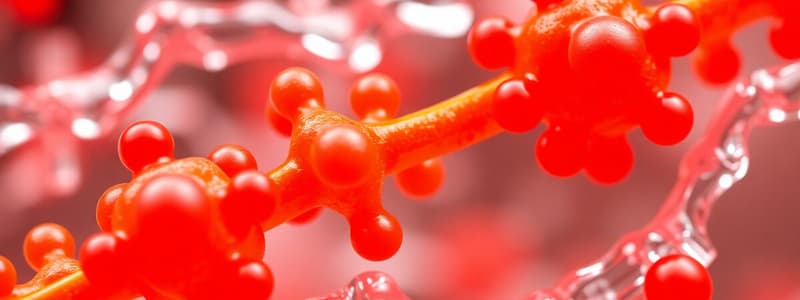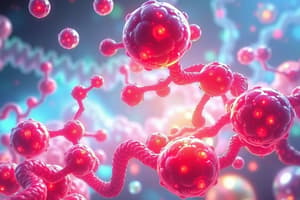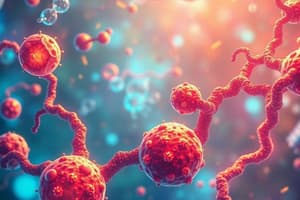Podcast
Questions and Answers
How does a non-competitive inhibitor affect enzyme activity?
How does a non-competitive inhibitor affect enzyme activity?
- By increasing the activation energy of the reaction.
- By binding to a site other than the active site, altering the enzyme's shape. (correct)
- By directly competing with the substrate for binding to the active site.
- By decreasing the concentration of the substrate.
Which of the following statements accurately compares anabolic and catabolic pathways?
Which of the following statements accurately compares anabolic and catabolic pathways?
- Anabolic pathways require energy to synthesize complex molecules from simpler ones, while catabolic pathways release energy by breaking down complex molecules into simpler ones. (correct)
- Anabolic and catabolic pathways both release energy, but anabolic pathways do so more efficiently.
- Anabolic pathways are exergonic, while catabolic pathways are endergonic.
- Anabolic pathways release energy by breaking down complex molecules into simpler ones, while catabolic pathways require energy to build complex molecules from simpler ones.
Why is ATP an important molecule in metabolism?
Why is ATP an important molecule in metabolism?
- It captures energy from sunlight to synthesize glucose.
- It is the final electron acceptor in the electron transport chain.
- It provides energy for cellular processes through hydrolysis. (correct)
- It directly converts glucose into carbon dioxide and water.
Which stage of cellular respiration generates the most ATP?
Which stage of cellular respiration generates the most ATP?
In which part of the eukaryotic cell do the Krebs cycle reactions take place?
In which part of the eukaryotic cell do the Krebs cycle reactions take place?
What is the primary role of oxygen in cellular respiration?
What is the primary role of oxygen in cellular respiration?
During glycolysis, glucose ($C_6H_{12}O_6$) is broken down into what?
During glycolysis, glucose ($C_6H_{12}O_6$) is broken down into what?
What is the main purpose of fermentation?
What is the main purpose of fermentation?
What role does water play in the light reactions of photosynthesis?
What role does water play in the light reactions of photosynthesis?
Which of the following correctly describes the relationship between the light reactions and the Calvin cycle?
Which of the following correctly describes the relationship between the light reactions and the Calvin cycle?
What is the role of Rubisco in the Calvin cycle?
What is the role of Rubisco in the Calvin cycle?
How many molecules of $CO_2$ are required to produce one molecule of G3P in the Calvin cycle?
How many molecules of $CO_2$ are required to produce one molecule of G3P in the Calvin cycle?
Which of the following is a direct product of the light reactions of photosynthesis?
Which of the following is a direct product of the light reactions of photosynthesis?
What is the function of the electron transport chain in both cellular respiration and photosynthesis?
What is the function of the electron transport chain in both cellular respiration and photosynthesis?
If a plant is exposed to a toxin that inhibits the function of ATP synthase, which process would be most directly affected?
If a plant is exposed to a toxin that inhibits the function of ATP synthase, which process would be most directly affected?
Flashcards
Metabolism
Metabolism
The sum of all chemical reactions in an organism.
Anabolic Pathways
Anabolic Pathways
Build complex molecules and require energy (+ΔG, endergonic).
Catabolic Pathways
Catabolic Pathways
Break down molecules (release energy, -ΔG, exergonic).
ATP (Adenosine Triphosphate)
ATP (Adenosine Triphosphate)
Signup and view all the flashcards
Exergonic Reactions (-ΔG)
Exergonic Reactions (-ΔG)
Signup and view all the flashcards
Endergonic Reactions (+ΔG)
Endergonic Reactions (+ΔG)
Signup and view all the flashcards
Reaction Coupling
Reaction Coupling
Signup and view all the flashcards
Enzymes
Enzymes
Signup and view all the flashcards
Competitive Inhibition
Competitive Inhibition
Signup and view all the flashcards
Non-Competitive Inhibition
Non-Competitive Inhibition
Signup and view all the flashcards
Feedback Inhibition
Feedback Inhibition
Signup and view all the flashcards
Purpose of Cellular Respiration
Purpose of Cellular Respiration
Signup and view all the flashcards
Glycolysis
Glycolysis
Signup and view all the flashcards
Pyruvate Oxidation
Pyruvate Oxidation
Signup and view all the flashcards
Citric Acid Cycle (Krebs Cycle)
Citric Acid Cycle (Krebs Cycle)
Signup and view all the flashcards
Study Notes
Metabolism and Enzymes
- Metabolism is the sum of all chemical reactions in an organism.
- Anabolic pathways build complex molecules and require energy (+ΔG, endergonic).
- Catabolic pathways break down molecules and release energy (-ΔG, exergonic).
- ATP (Adenosine Triphosphate) stores and transfers energy within cells.
- ATP hydrolysis (breaking the phosphate bond) releases energy.
Free Energy (ΔG) and Reaction Types
- Exergonic reactions (-ΔG) release energy and are spontaneous.
- Endergonic reactions (+ΔG) require energy input and are non-spontaneous.
- Reaction coupling uses exergonic reactions like ATP hydrolysis to drive endergonic reactions.
Enzymes: Function and Structure
- Enzymes are proteins that speed up reactions by lowering the activation energy (Eₐ).
- Enzymes are highly specific, binding to substrates at the active site.
- Enzymes do not change the overall ΔG of a reaction.
- Enzymes are reusable.
Enzyme Inhibition
- Competitive inhibition occurs when an inhibitor binds to the active site, blocking the substrate.
- Non-competitive inhibition occurs when an inhibitor binds elsewhere, changing the enzyme's shape.
- Feedback inhibition involves the product of a pathway acting as an inhibitor to prevent excessive production.
Cellular Respiration Overview
- Cellular respiration converts glucose into ATP for energy.
- The summary equation: C₆H₁₂O₆ + 6O₂ → 6CO₂ + 6H₂O + ATP
- The key stages in the process are glycolysis, pyruvate oxidation, citric acid cycle, and oxidative phosphorylation.
Glycolysis (Stage 1)
- Glycolysis occurs in the cytoplasm.
- Glucose (6C) is converted into 2 pyruvate molecules (3C).
- The stages net yield is 2 ATP (via substrate-level phosphorylation) and 2 NADH (electron carriers).
Pyruvate Oxidation (Stage 2)
- Pyruvate oxidation takes place in the mitochondrial matrix.
- Pyruvate is converted to Acetyl-CoA.
- The products per glucose molecule are 2 Acetyl-CoA, 2 NADH, and 2 CO₂.
Citric Acid Cycle (Krebs Cycle) (Stage 3)
- The Citric Acid Cycle occurs in the mitochondrial matrix.
- Acetyl-CoA is oxidized to CO₂.
- The products per glucose are 6 NADH, 2 FADH₂, 2 ATP (substrate-level phosphorylation), and 4 CO₂.
Oxidative Phosphorylation (ETC & Chemiosmosis) (Stage 4)
- The electron transport chain (ETC) is in the inner mitochondrial membrane.
- NADH and FADH₂ donate electrons.
- Oxygen is the final electron acceptor, which forms water (H₂O).
- ATP yield is 26-28 ATP per glucose via ATP Synthase which is powered by a H+ gradient.
Anaerobic Respiration (Fermentation)
- Anaerobic respiration occurs when oxygen is unavailable.
- Lactic acid fermentation occurs in muscle cells and bacteria.
- Alcohol fermentation occurs in yeast and bacteria.
- Only 2 ATP per glucose are produced (from glycolysis).
Photosynthesis Overview
- Converts light energy into chemical energy in glucose.
- The summary equation: 6CO₂ + 6H₂O + light energy → C₆H₁₂O₆ + 6O₂
- The two major stages are light reactions and the Calvin cycle.
Light Reactions (Stage 1)
- Takes place in the thylakoid membrane.
- Light energy is used to make ATP and NADPH.
- Photosystem II (P680) absorbs light and splits water (H₂O), releasing O₂.
- The electron transport chain (ETC) pumps H+ ions, creating a gradient.
- Photosystem I (P700) absorbs more light, thus produces NADPH.
- ATP Synthase makes ATP via chemiosmosis
Calvin Cycle (Stage 2)
- The Calvin Cycle occurs in the stroma.
- It uses ATP and NADPH to convert CO₂ into sugar (G3P).
- During carbon fixation, CO₂ binds to RuBP via the enzyme Rubisco.
- During reduction, ATP and NADPH convert 3-PGA into G3P.
- During regeneration, some G3P makes glucose, and the remainder regenerates RuBP.
- The end product is G3P used to form glucose, starch, and cellulose.
Key Concept Comparison
- Chapter 8 focuses on energy and Enzymes.
- Chapter 9 focuses on cellular respiration.
- Chapter 10 focuses on photosynthesis.
- ATP is the energy source discussed for Chapter 8
- Glucose is the energy source discussed for Chapter 9
- Sunlight is the energy source discussed for Chapter 10
- Chapter 8 includes anabolic vs. catabolic pathways
- Chapter 9 includes glycolysis, citric acid cycle, and the ETC
- Chapter 10 includes light reactions and the Calvin cycle
- The key organelles for chapter 9 are mitochondria
- The key organelles for chapter 10 are chloroplasts
- Enzyme activity and inhibition are the key reactions from chapter 8
- Glycolysis, the Citric Acid Cycle and the ETC are the key reactions from chapter 9
- Light absorbtion and Carbon Fixation are the key reactions from chapter 10
Studying That Suits You
Use AI to generate personalized quizzes and flashcards to suit your learning preferences.



